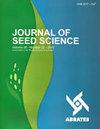基于α-淀粉酶活性研究枯草芽孢杆菌QM3促进小麦种子萌发的机制
IF 1.2
4区 农林科学
Q3 AGRONOMY
引用次数: 1
摘要
摘要:枯草芽孢杆菌促进小麦种子萌发的机理一直受到许多学者的关注。本研究用枯草芽孢杆菌QM3对小麦种子进行萌发处理,可显著提高种子的发芽率和α-淀粉酶活性。利用α-淀粉酶抑制剂和启动子研究细菌与α-淀粉酶的关系。与抑制剂组(10 mmol。经枯草芽孢杆菌QM3 (106 CFU.mL-1)处理的种子α-淀粉酶活性提高了19.8%。这表明抑制已经减轻。同样,共处理组α-淀粉酶活性(2 mmol。L-1 CaCl2和106 CFU。mL-1枯草芽孢杆菌QM3)高于单独启动子,达到14.9%。α-淀粉酶同工酶电泳结果显示,凝胶中存在3种同工酶类型,经枯草芽孢杆菌QM3 (106 cfuml . 1)处理后,α-淀粉酶同工酶的表达量显著增加,这主要体现在条带宽度和亮度上,尤其是Cα条带。此外,还对其他3种小麦种子的发芽率、α-淀粉酶活性和同工酶电泳进行了测试,得到了相似的结果。因此,枯草芽孢杆菌QM3促进种子萌发的可能机制之一是作为一种潜在的外源因子,可以增强α-淀粉酶的活性和表达。本文章由计算机程序翻译,如有差异,请以英文原文为准。
Wheat seed germination based on α-amylase activity to study promoting mechanism of Bacillus subtilis QM3
Abstract: The mechanism of promoting wheat seed germination by Bacillus subtilis has been paid great attention by many scholars. The germination rate and α-amylase activity of wheat seeds were significantly increased after germinating with Bacillus subtilis QM3 in this paper. Inhibitor and promoter of α-amylase were used to study relationship between bacteria and α-amylase. Compared with inhibitor group (10 mmol.L-1 EDTA), α-amylase activity of seeds treated by B. subtilis QM3 (106 CFU.mL-1) increased by 19.8%. It indicates that the inhibition has been alleviated. Similarly, α-amylase activity of co-treated group (2 mmol.L-1 CaCl2 and 106 CFU.mL-1 B. subtilis QM3) was higher than that of the promoter alone, reaching 14.9%. Furthermore, the results of α-amylase isozyme electrophoresis showed that there were three isozyme types in the gels, and the expression of α-amylase isoenzyme was significantly increased after treatment with B. subtilis QM3 (106 CFUmL.-1), which was reflected in the width and brightness of band mainly, especially band Cα. In addition, germination rate, α-amylase activity and isozyme electrophoresis of other three kinds of wheat seeds were also tested and similar results were obtained. Therefore, one of the possible mechanisms by which B. subtilis QM3 promotes seed germination is as a potential exogenous factor that can enhance activity and expression of α-amylase.
求助全文
通过发布文献求助,成功后即可免费获取论文全文。
去求助
来源期刊

Journal of Seed Science
Agricultural and Biological Sciences-Agronomy and Crop Science
CiteScore
2.00
自引率
30.00%
发文量
28
审稿时长
12 weeks
期刊介绍:
From 2017 the Journal of Seed Science (JSS) will circulate online version only.
Original scientific studies and communications, not yet published or submitted to another journal for publication and written in Portuguese or English, will be accepted for publication. For manuscripts submitted in English, the authors should provide an adequated version.
The SCIENTIFIC COMMUNICATION is a category of scientific manuscript which describes a technique, an equipment, new species or observations and surveys of limited results. It has the same scientific rigor as the “Scientific Articles” and the same value as a publication. The classification of a manuscript as a SCIENTIFIC COMMUNICATION is based on its content and scientific merit but it can be a preliminary study, simple and not definitive on a certain subject, with publication justified by its uniqueness and contribution to the area.
The Editorial Board of the JSS may invite leading authors of recognized reputation to compose specific Review Articles covering topics of their specialization that will convey to the scientific community the state-of-the-art knowledge related to the specific theme.
 求助内容:
求助内容: 应助结果提醒方式:
应助结果提醒方式:


